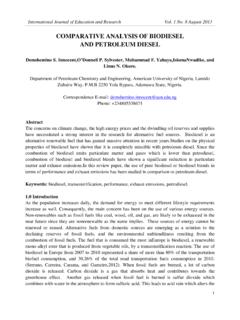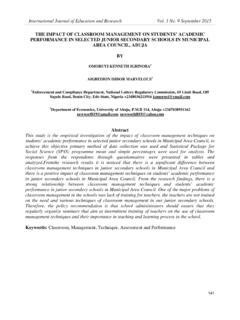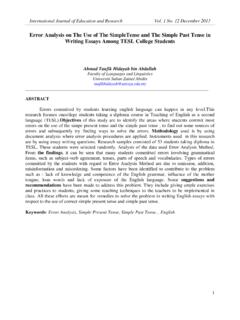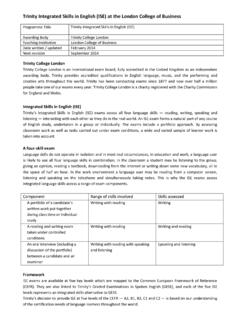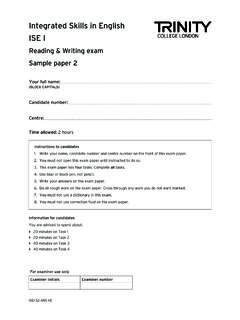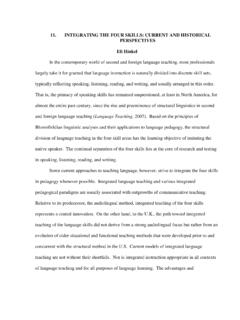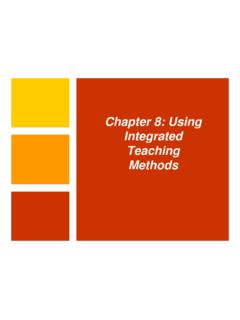Transcription of INTEGRATED APPROACH IN TEACHING ENGLISH ... - ijern.com
1 International Journal of Education and Research Vol. 2 No. 4 April 2014. INTEGRATED APPROACH IN TEACHING ENGLISH LANGUAGE: THE PRACTICE IN KENYA. Manyasi N. Beatrice (PhD). Maasai Mara University School of Arts and Social Sciences, Box 861- 20500, Narok, Kenya Cell phone: +254721883793. ABSTRACT. The purpose of the study was to establish how the INTEGRATED APPROACH was used in TEACHING cultural practices and ENGLISH language skills in the set book novel: The River and the Source by Magaret Ogola. The findings revealed that teachers analyzed cultural practices in isolation without integrating the TEACHING of literature with the language skills of listening, speaking, reading and writing. Punctuation and grammar was also not taught. The instructional objectives focused on identifying and illustrating the cultural issues in the novel. Teachers emphasized on the cognitive domain ignoring the psychomotor and the affective domains, hence there was a disparity between curriculum developers' expectations and classroom practice.
2 Key words: INTEGRATED APPROACH , ENGLISH Language skills , TEACHING , Culture. 1. Introduction This paper highlights the importance of using literature to teach ENGLISH language while sensitizing learners to be culturally literate in the diverse cultural environment in Kenya. The paper focuses itself on cultural issues in The River and the Source,' by Magaret Ogola, which is the current set book in secondary schools in Kenya; and how it can be used to facilitate the learning of listening, speaking, reading and writing skills . The National Center for Cultural Competence defines culture as an INTEGRATED pattern of human behavior that includes thoughts, communications, languages, practices, beliefs, values, customs, courtesies, rituals, manners of interacting and roles, relationships and expected behaviors of a racial, ethnic, religious or social group; and the ability to transmit the above to succeeding generations (Goode, Sockalingam, Brown, & Jones, 2000).
3 The Kenya Nation Education Commission reformed the education system inherited from the colonial government to make it responsive to the needs of independent Kenya. The National Committee on Educational objectives and policies focused on redefining Kenya's educational policies and objectives, considering National unity, economic, social and cultural aspirations of the 253. ISSN: 2201-6333 (Print) ISSN: 2201-6740 (Online) people of Kenya (Gachathi Report, 1976). These issues were considered fundamental to the success of the nation given that it has over 40 different ethnic communities. Policy Initiatives , Sessional paper No. 1 of 2005 was developed to help avoid policy conflict, resources wastage and duplication. It gives future direction of education in Kenya. It encourages collaboration of parties in the education sector and expansion if existing institutions to cater for the ever-increasing demand.
4 Contemporary issues such as Universal Primary Education (UPE), Information and Communication Technology (ICT), Open and Distance Learning (ODL) are discussed in detail. The paper outlines the philosophy, vision, mission, goals and objectives of education and training in Kenya. Education in Kenya is guided by the philosophy of education and training for social Cohesion as well as Human and Economic Development (MOES &T, 2005). Social cohesion in Kenya is affected by the diverse cultures of the different speech communities. ENGLISH being a compulsory subject in secondary schools, is used as a vehicle to know about the diverse cultures hence unity in diversity. One of the recommended set books is usually written by a local author to highlight cultural issues. The current set book is, The River and the Source' by Margaret Ogola. Ogola (2002) writes about the traditional culture in Kenya.
5 She specifically draws from the Luo speech community which is not much different from other speech communities in Kenya. Teachers of ENGLISH can use the novel to make learners appreciate the Luo culture and use it to draw parallels from other speech communities. The detailed presentation of cultural issues in Kenya, much of which represent the larger African culture has made the novel to be approved by the Kenya Institute of Curriculum Development as a set book in secondary schools for the second time. The aim is to achieve the objective of To enhance understanding and respect for own and other people's cultures and their place in the contemporary society.. Purpose of the Study The purpose of the study was guided by the research questions: What cultural practices were taught from the novel? What language skills were INTEGRATED while TEACHING the cultural practices?
6 Literature Review The Philosophy of Education in Kenya The Philosophy of TEACHING is the rational of TEACHING or a personal vision of TEACHING (O'Cornor 1992). Education in Kenya is guided by the philosophy of Education and Training for social cohesion as well as Human and Economic Development. (Ministry of Education 2005). Social cohesion is only possible when people understand their culture and respect other people's culture, given that Kenya is made up of many tribes. The varied cultures can be experienced through reading several literal texts based on the culture of different communities. The importance of culture in education is also supported by the idealism philosophy. The Idealism Philosophy was advanced by Plato (427-347 ) and Froebel (1782-1852). This philosophy advocates that learners should be taught moral values and intellectual knowledge which 254.
7 International Journal of Education and Research Vol. 2 No. 4 April 2014. they needed in order to become model citizens. (Myra and David 2000). Teachers should instill respect for authority, perseverance, fidelity to duty and consideration for others. Learners should be taught to be culturally literate'- to be familiar with the people, events, and institutions that shape their society. In Kenya, education should nurture our cultural heritage ( MOES&T 2005). The eleventh objective of TEACHING ENGLISH in secondary schools in Kenya is, appreciate and respect own as well as other people's culture (MOES&T 2002). This paper is based on the fifth objective of secondary education; to enhance understanding and respect for own as well as other people's culture and their place in contemportary society (MOES&T 2002). ( ). The objectives of TEACHING reading in Kenya are to provide learners with the opportunity to: i.
8 To acquire necessary knowledge, skills and attitudes for the development of self and the Nation. ii. To provide love for and loyalty to the Nation. iii. To Promote harmonious co existence among the peoples of Kenya iv. To develop mentally, socially, morally, physically and spiritually v. To enhance understanding and respect for own and other people's cultures and their place in the contemporary society. The INTEGRATED APPROACH In Kenya, the Ministry of Education stipulates that ENGLISH language must be taught using the INTEGRATED APPROACH ; hence, the subject is called INTEGRATED ENGLISH . This involves TEACHING ENGLISH language and Literature in ENGLISH as one subject in the school curriculum. The Kenya Secondary School Syllabus explains the issue of integration as follows: merging two autonomous but related entities in order to strengthen and enrich both. Through exposure to literature the learner will improve their language skills .
9 They will not only enrich their vocabulary but also learn to use language in a variety of ways. Similarly, an improved knowledge of the language will enhance the 'learner's appreciation of literary material. On yet another scale, integration means that no language skill should be taught in isolation. Listening, speaking, reading and writing skills should complement each It has been established that TEACHING language structures in isolation is not only boring, but it also tends to produce learners who lack communicative competence (KIE. 2002, ). The INTEGRATED APPROACH has similarities with what Richards and Rodgers (2001:109) call the Whole Language APPROACH . All the skills of language: writing, reading, listening and speaking should be INTEGRATED in learning and TEACHING . Methodology The study used the qualitative research methodology. Jwan & Ong'ondo, ( 2011) say that such a methodology uses a relatively small number of cases considered in terms of details.
10 The paradigm was appropriate for the study because the researcher could generate data about the cultural practices taught from the novel and the language skills INTEGRATED while TEACHING the cultural practices. Due to their real life setting, qualitative research is more reality based hence the researcher found out the 255. ISSN: 2201-6333 (Print) ISSN: 2201-6740 (Online) reality about the use of the recommended INTEGRATED APPROACH to teach ENGLISH language in secondary schools in Kenya. Ethnography method was used during the study. It emphasizes the importance of studying at firsthand what people do and say in particular contexts (Jwan and Ong'ondo, 2011; Creswell, 2007; Yin, 2009). It involves a researcher participating in people's daily lives for an extended period of time: observing, listening, asking questions through formal and informal interviews (Hammersley and Artkinson, 2007).
